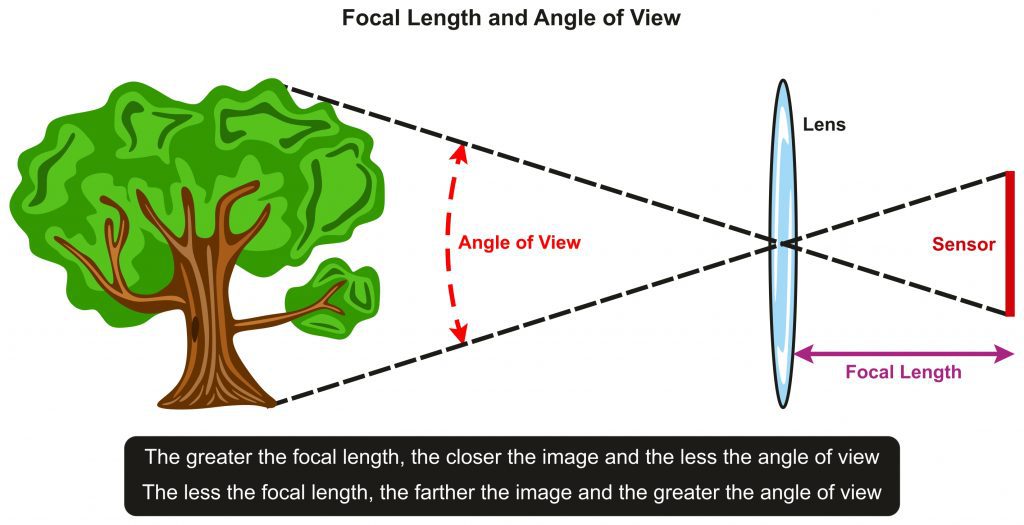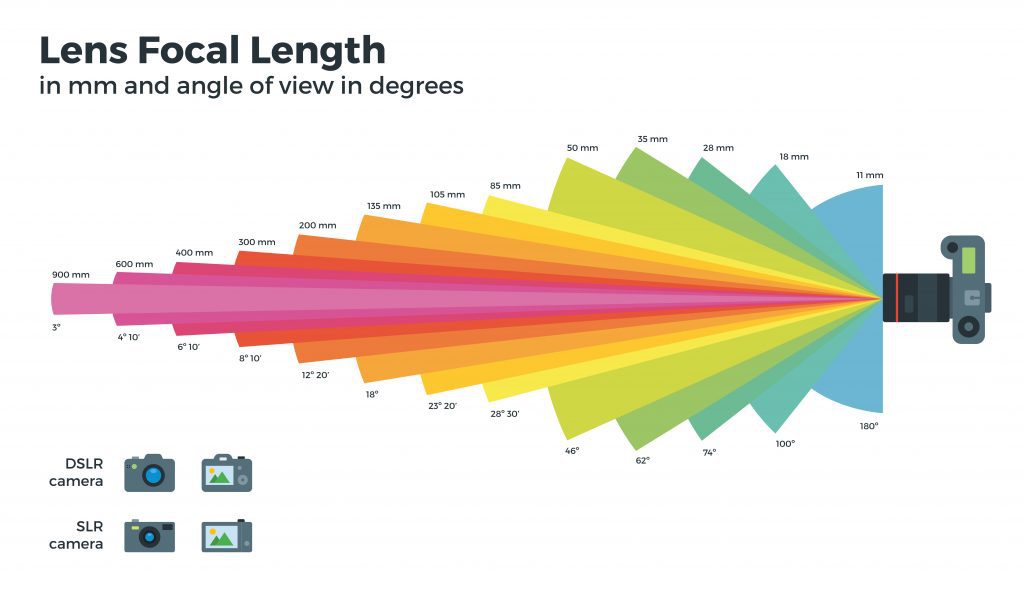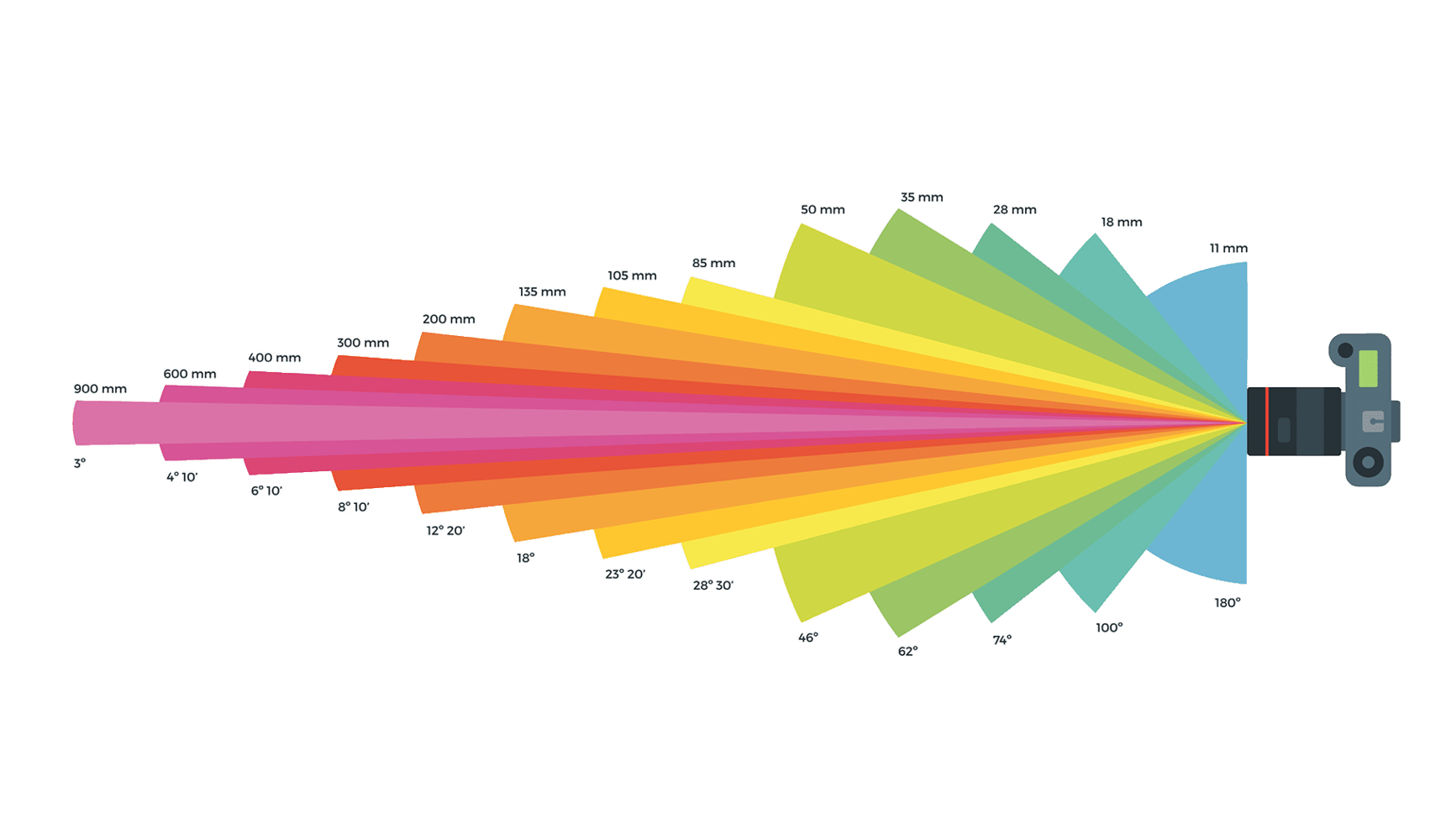When you get down to the details, focal length in photography can be a confusing topic, even for photographers who have been shooting for a long time.
It’s the type of thing you learn when you’re just starting out but then you tend to forget what it means on a technical level. You start thinking in more useful terms like “28mm is wide” and “85mm is a medium telephoto good for portraits”, rather than on information that’s more useful to an optical engineer.
Nevertheless, knowing the practical and creative applications of focal length in photography is essential, and knowing a bit of the technical side never hurts as well.
So if you’re wondering ‘what is focal length in photography?’, we take an in-depth look at the topic here.
A Technical Look at Focal Length in Photography
Every camera lens has a focal length, and it’s printed on the front of the vast majority of them.
The focal length of a lens has nothing to do with its physical dimensions. Rather, it refers to the distance between a camera’s sensor (or film) and the optical center of a lens. You may not have heard of this term before, so what is the optical center of a lens?
Lenses are made with multiple lens elements and groups. The optical center of a lens is where light converges among all these lens elements to form the sharpest image the lens is capable of.
While this is interesting information to know, the specifics are honestly not all that important to know as a photographer. Photography is an art form and cameras and lenses are just tools that allow us to create. When you’re out shooting in the field, you should be thinking about lighting, composition, and expressing yourself, rather than the science and physics behind how lenses work.
That being said, the focal length of a lens does tell us some important information that we can use to our advantage.
Angle of View

The most important thing that focal length tells us as photographers is the lens’ angle of view. Angle of view refers to the angle at which a lens takes in light and thus how much of a scene a lens takes in. The wider the angle of a lens, the more of the scene in front of the lens it captures.
The angle of view also affects how large objects appear in front of the lens. Longer focal lengths have a magnifying effect, so subjects photographed with them will appear larger than what we see with our eyes. It’s the opposite with wide-angle lenses; a subject that we see close before us looks large with our own eyes but will look small in comparison when photographed with a wide-angle lens.
Field of View
Another important thing that focal length in photography tells us is the field of view. Field of view is a similar but different concept to angle of view. Field of view is the angle of a scene that a lens takes in but in relation to the camera’s sensor size.
A lens’ angle of view is a fixed property that doesn’t change. However, a lens’ field of view can change when you pair it with different camera sensor sizes. For example, a 50mm lens on a full-frame camera body will give you a 50mm field of view. But pair it with an APS-C camera body and it results in a 75mm field of view because of the 1.5x crop factor.
Focal Lengths

You have a wide range of focal lengths to choose from for photography so it’s helpful to know which ones to use for whatever situation you find yourself in. There are no hard and fast rules on what focal length to use and when but there are some general guidelines that make for a good starting point.
Additionally, you’ll likely find that you gravitate towards certain focal lengths that fit you and your style. I personally really like the 35mm focal length. It feels just wide enough to me to produce a personal and intimate look without forcing you to get uncomfortably close to your subjects. It works great for street photography, documentary photography, and weddings.
You may find that you gravitate more towards 50mm or some other focal length lens, and it’s good to know your own preferences, which you can only learn by getting out there and shooting and experimenting with different focal lengths. If you do a lot of portraits, you may find that you like lenses in the 85mm-200mm range, which give you lens compression that is more flattering to your subjects.
Whatever focal lengths you choose, it’s a good idea to choose them with intention so that you use an appropriate lens for the type of photography you’re doing.
Here are the categories of focal lengths that you have to choose from.
Ultra Wide Angle Lenses
Ultra wide-angle lenses are typically 24mm lenses and wider. This category ranges from very wide but with minimal distortion all the way to fisheye lenses, where the field of view is so wide that the edges of the frame distort and curve.
Ultra wide-angle lenses aren’t appropriate for every type of photography, but they can really excel when used in the right situations. If you want to create broad, sweeping vistas when doing landscape photography, an ultra-wide-angle lens is the way to go. They’re also great for interiors if you do real estate photography.
Ultra wide-angle lenses give you a very deep depth of field, which is great for instances when you want everything in the frame in focus.
If you’re photographing people, you should be careful with ultra-wide-angle lenses, as the distortion can make people look heavier than they really are.
Wide Angle Lenses
Wide-angle typically refers to equivalent lenses from 28mm to 35mm in focal length. These lenses obviously arent’ as wide as ultra-wide-angle lenses, but they can still produce impressive, wide, sweeping vistas in the right situations.
Wide-angle lenses are nice because they make it a bit easier to control your compositions and keep things from being messy compared to ultra-wide-angle lenses. They also typically don’t suffer from as much distortion as ultra-wide-angle lenses.
If you like street or documentary photography, you can’t go wrong with a wide-angle lens. Wide-angle lenses do force you to get somewhat close to your subjects to fill the frame, so that’s something that you have to get used to. I rarely shoot at 24mm for street photography because I find it a bit too wide, but 28mm to 35mm lenses for street photography are ideal in my opinion.
Wide-angle lenses can be used for portraits, but more so for environmental or full-body portraits, because they do have some level of distortion that can be unflattering.
Standard Focal Lengths
Standard focal length in photography typically refers to 35mm to 70mm equivalent lenses. Somewhere in the range of 35mm to 50mm is what the human eye sees, so these lenses can feel very natural to use from the get-go.
What’s nice about standard focal length lenses is that they have very little distortion. This makes them a popular option for portraiture. Another appealing aspect of these lenses is that you can get a shallow depth of field with them when you want to blur out backgrounds.
Lastly, optical engineers are able to design standard focal length lenses to be among the sharpest lenses on the market.
Telephoto Lenses
Telephoto lenses are in the 70mm to 300mm range. These lenses are able to capture scenes from far away, so they’re used by wildlife and sports photographers. These lenses allow you to not disturb a scene from a distance.
Telephoto lenses can also be used for portraits to really blur out backgrounds, which can come in handy when you’re dealing with a distracting background.
You have to really nail focus with telephoto lenses because they have a shallower depth of field.
Telephoto lenses are great when you need them but they are costly. Typically, once you get into telephoto range, the longer the focal length, the more expensive the lens.
Super Telephoto Lenses
Super telephoto lenses have focal lengths longer than 300mm and allow you to photograph subjects from very far distances away. These lenses can be used for photographing birds and other wildlife so that you don’t disturb their environment. They’re also used so that you can safely photograph dangerous wildlife from a distance.
Super telephoto lenses are serious pieces of equipment. Most are so big and heavy that you wouldn’t want to carry your setup from your camera body because you could damage the lens mount that way. As a result, they come with a tripod collar so that you can mount the lens to a tripod or monopod. They typically come with a heavy-duty case to carry them around and store them in.
Super telephoto lenses are also super expensive. They cost in the tens of thousands of dollars, so they’re a significant investment. For anyone who wants to get into the type of photography where super-telephoto lenses are needed, the cost is a pretty big barrier to entry.
Prime Lenses & Zoom Lenses
Prime lenses have a fixed focal length, meaning it doesn’t change. You have to zoom with your feet with prime lenses.
Prime lenses are nice partly because of their focal length limitation. With zoom lenses, having the option to zoom can be a distracting feature that causes you to miss shots because it’s an extra setting that you have to think about. With prime lenses, you have your aperture, shutter speed, and ISO to deal with but then you just zoom with your feet.
Another appealing trait about prime lenses is that they’re optically sharper than zoom lenses. Manufacturers have improved zoom lens performance in recent years and decades but they still lag behind the performance of prime lenses in terms of optics.
Prime lenses also are able to have wider apertures, so they’re better in low-light situations.
A big thing for me too is that prime lenses are smaller and lighter than zoom lenses on average. If you value having compact gear that doesn’t weigh you down, prime lenses are a good option.
Related:
Zoom lenses have their pros and cons as well.
Zoom lenses have variable apertures, meaning they have a range of focal lengths that you can utilize. Zoom lenses are more versatile in the sense that you have more options to work with. If you’re stuck in one spot and you can’t physically move, or if you’re just plain lazy, they have an advantage over prime lenses.
Some typical zoom ranges for full-frame cameras include 12-24mm, 24-70mm, and 70-200mm. These zoom lenses tend to be big and heavy.
APS-C camera systems have zoom lenses that are a bit more manageable in size and weight, such as Fujifilm’s kit 18-55mm, which comes out to around 27-83mm in full-frame terms. This is a very useful and versatile focal range. This particular lens has a variable aperture of f/2.8-f/4. Variable aperture lenses are not ideal because they limit low light capabilities but they do allow lenses to be smaller and lighter.
Zoom lenses with very wide focal ranges are also an option. These are lenses with focal ranges such as 18-300mm. As you can imagine, these lenses give you a lot to work with. One minute you can be taking a wide-angle shot and the next, you’re using the telephoto end to photograph something from really far away.
Super zooms are nice because they can replace multiple lenses, making them great for travel photography. The only downside is that their image quality tends to not be as good as primes or zooms with less focal range.
Related:
What Focal Length to Use
Photography is totally subjective, so it’s up to you as to what focal length you use. The best way to find out what focal lengths you like is to try a bunch of different focal lengths and do a lot of photography.
However, if you’re new to photography and want to know a good place to start, try these focal lengths for these situations:
Landscape Photography/Real Estate Photography
Use an ultra-wide angle for shots in very tight spaces or if you’re photographing interiors or doing landscape photography.
Related:
- Best Canon Lenses for Landscape Photography
- Best Nikon Lenses for Landscape Photography
- Best Sony Lenses for Landscape Photography
Street/Documentary Photography
I prefer wide-angle lenses for street photography but have used up to 50mm. My preference for street photography is 35mm but I do go as wide as 28mm, mostly when I’m shooting with my Ricoh GR III.
Wide-angle lenses make for the most compelling street photography images in my opinion.
Related:
- Best Canon Lenses for Street Photography
- Best Nikon Lenses for Street Photography
- Best Canon Lenses for Traveling Photography
- Best Nikon Lenses for Traveling Photography
Portrait Photography
85mm is probably the most used focal length for portraits, and for good reason. It’s long enough to give you a comfortable working distance between you and your subject, and they have nice compression with little to no distortion. If you really want a lot of compressions, you can go up to 200mm.
A lot of portrait photographers like 56mm as well. I’ve also seen wide-angle lenses be used effectively for environmental portraits.
Related:
- Best Canon Lenses for Portraits Photography
- Best Nikon Lenses for Portraits Photography
- Best Sony Lenses for Portraits Photography
Sports/Wildlife
For sports and wildlife, you need something with reach because you can’t get that close to your subjects. 300mm+ is basically a necessity to have in your bag.
Related:
- Best Canon Lenses for Sports Photography
- Best Nikon Lenses for Sports Photography
- Best Sony Lenses for Sports Photography
- Best Canon Lenses for Wildlife Photography
- Best Nikon Lenses for Wildlife Photography
Final Thoughts
If you’re a photographer, creating art and documenting is what’s important. Lenses are just tools that we have at our disposal in order to achieve a certain result. So keep in mind that at least for photographers, knowing the technical side of focal length in photography isn’t even necessary.
What’s important is knowing the characteristics of focal lengths so that you can use that knowledge to decide what lenses to use, when to use them, and how. Wide-angle lenses make things that are close appear farther away and distort things. Telephoto lenses magnify what they’re pointed at so that far away things appear closer than they really are.



